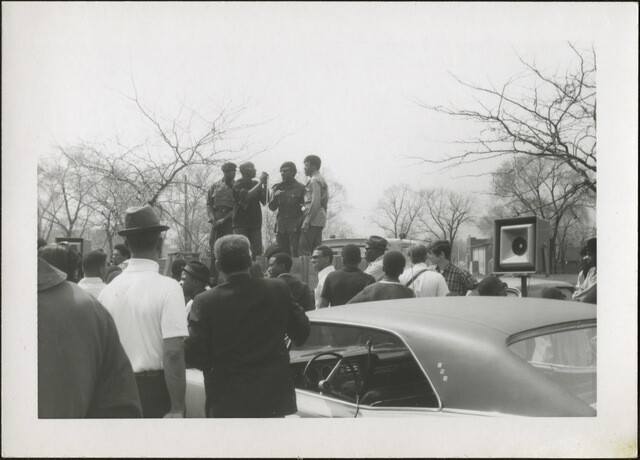PHOTOS: 1968 Kansas City Race Riots

Martin Luther King Jr. was assassinated on April 4, 1968. Students and community leaders in Kansas City, Missouri, wanted district officials to shut down KCPS schools on the day of his funeral, April 9, so they could mourn. When KCPS refused to do so, students from Lincoln Prep, Manual, and Central high schools walked out.UMKC - LaBudde Special Collections
Walking in the eastbound lanes of I-70, the students marched west toward City Hall, against the flow of traffic.UMKC - LaBudde Special Collections
Bruce R. Watkins joined the march on I-70, leading with a raised fist.UMKC - LaBudde Special Collections
The students all met up at Parade Park, where they and some community leaders spoke.UMKC - LaBudde Special Collections
Then-Mayor Ilus Davis met the students at the park. He heard their concerns and permitted them to protest at City Hall.UMKC - LaBudde Special Collections
As a report commissioned by the mayor would later show, the issues that gave rise to the riots ran much deeper than school administration’s decision keep classrooms open.UMKC - LaBudde Special Collections
As students made their way downtown, police were preparing for the crowd.UMKC - LaBudde Special Collections
Protestors filled the courtyard. One retired officer who was there that day remembered the number of people coming seemed as large as 1,000 people, though it was closer to 300UMKC - LaBudde Special Collections
Officers patrolled the area, some equipped with guns, others wearing gas masks and wielding batons.UMKC - LaBudde Special Collections
Demonstrators stood on the steps of City Hall to make speeches.UMKC - LaBudde Special Collections
As word spread of what the students had done, many adults joined the crowd in support. Some would go on to found or get involved in organizations that worked to support minorities and promote unity.UMKC - LaBudde Special Collections
The police officers lined up shoulder-to-shoulder. A black woman walked up and down that line, yelling and cursing. Someone from the protesting crowd behind her hurled a glass soda bottle at the officers.UMKC - LaBudde Special Collections
At that moment, the first can of tear gas exploded.UMKC - LaBudde Special Collections
The gas sent protestors scattering.UMKC - LaBudde Special Collections
Young students recalled feeling the sting of the tear gas for the first time.UMKC - LaBudde Special Collections
The retired officer said he never saw a need for the first can of tear gas to be thrown, but others had a more aggressive mindset toward the protestors.UMKC - LaBudde Special Collections
The gas split the crowd up, but demonstrators would come back together in the days that followed with a vengeance, burning parts of the city to the ground.UMKC - LaBudde Special Collections
Congressman Emanuel Cleaver II said 1968 was an “earth-shattering” year for Kansas City. Former Mayor Sly James said “the world lit up.”UMKC - LaBudde Special Collections
To get the students away from the tear gas, and to try to calm the situation, KCPS officials organized a dance at Holy Name Catholic Church. When police were called to the church in reference to a disturbance, the students began taunting the officers. The police threw cans of tear gas through windows into the basement. Some say they didn’t know there was a dance happening there. Nearly everyone says this is when the riots really began.UMKC - LaBudde Special Collections
Then-Mayor Ilus Davis declared a state of emergency and enforced the city’s first emergency curfew. The National Guard moved in.UMKC - LaBudde Special Collections
Police set up a command post at the Scottish Rite Temple.UMKC - LaBudde Special Collections
The Red Cross (van pictured near the back) was also on the scene.UMKC - LaBudde Special Collections
Many businesses were damaged or destroyed in the riots. The damage totaled $4 million in 1968, which would be closer to $29 million in 2018.UMKC - LaBudde Special Collections
The destruction was mostly contained to the area surrounding 31st and The Paseo. Congressman Emanuel Cleaver II said this was because “to go west of Troost was to die, and I think everybody realized that.”UMKC - LaBudde Special Collections
























